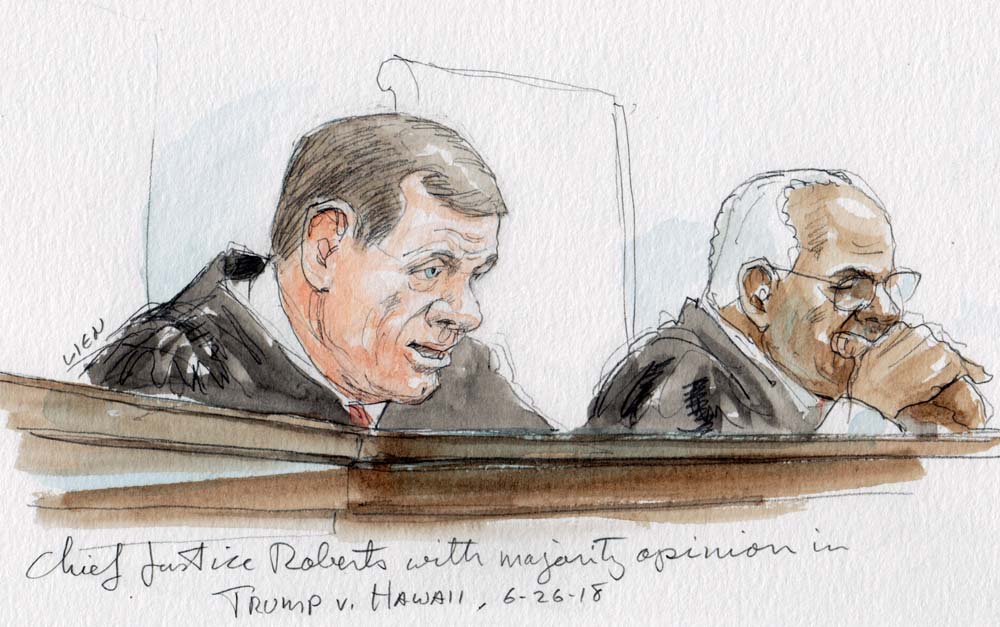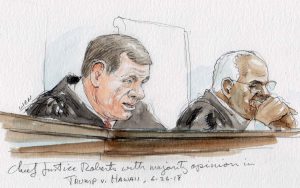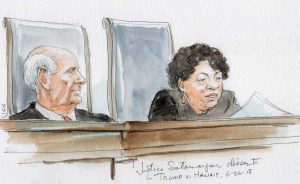Opinion analysis: Divided court upholds Trump travel ban (Updated)

on Jun 26, 2018 at 5:06 pm

[Editor’s Note: This post, originally published at 12:11 p.m., was expanded with additional analysis at 2:05 p.m.]
The Supreme Court today handed a major victory to the Trump administration. By a vote of 5-4, the justices rejected a challenge to President Donald Trump’s September 2017 order – often referred to as the “travel ban” – restricting immigration to the United States by citizens of eight countries, most (but not all) of which are predominantly Muslim. In an opinion by Chief Justice John Roberts, the majority relied on the national security justifications for the ruling, while Justice Sonia Sotomayor, in dissent, lamented that the court had “blindly” endorsed “a discriminatory policy motivated by animosity toward” Muslims.
The order under scrutiny at the court was the most recent of three orders issued by the president since he took office in 2017. The first order, issued on January 27, 2017, imposed a 90-day ban on the entry into the United States of citizens from seven overwhelmingly Muslim countries – Iran, Iraq, Libya, Syria, Somalia, Sudan and Yemen – and put a 120-day hold on the admission of refugees, although it contained an exception for refugees who were religious minorities in their home countries.
After the lower federal courts blocked the Trump administration from enforcing the January 2017 order, Trump replaced that order with a new and similar (although not identical) order in March 2017. That order also imposed a 90-day ban on the entry of citizens from six of the seven Muslim-majority countries included in the first order (removing Iraq from the list) and suspended the entry of refugees, this time without any exceptions for religious minorities. When lower courts barred the federal government from enforcing that order as well, the Trump administration went to the Supreme Court, which agreed in June 2017 to weigh in and allowed the government to implement part of the ban until the court could rule on the dispute. But that case was removed from the justices’ argument calendar in late September, after the March 2017 order expired and Trump issued the current version of the order.
The state of Hawaii returned to court to challenge the September 2017 order, arguing that – just like its predecessors – it violated both federal law and the U.S. Constitution. The Supreme Court allowed the government to implement the September 2017 order while it appealed lower-court rulings in favor of the challengers (a development that made today’s ruling less of a surprise, because the government would have needed five votes to block the lower court’s injunction barring enforcement of the order), and in January of this year the court announced that it would review the new challenge.
In his opinion for the majority, Roberts first rejected Hawaii’s argument that the September 2017 order exceeds the president’s authority under federal immigration laws. Section 1182(f) of the Immigration and Nationality Act, Roberts explained, “exudes deference” to the president, giving him “broad discretion to suspend” the entry of noncitizens into the United States. Under this provision, Roberts reasoned, the president can block noncitizens from coming into the United States if he determines that allowing them to enter “would be detrimental to the interests of the United States.” And the president has done exactly that here, Roberts emphasized, because the September 2017 order was the result of a “worldwide, multi-agency review” that concluded that the entry restrictions in the order were necessary, for example, to prevent foreign nationals from coming to the United States from countries that did not share enough information about their citizens to allow U.S. immigration officials to vet them properly. “In short,” Roberts concluded, “the language of §1182(f) is clear, and the Proclamation does not exceed any textual limit on the President’s authority.”
The majority similarly rejected Hawaii’s contention that the September 2017 order violates another provision of federal immigration law, Section 1152(a)(1)(A), which bars discrimination based on nationality in issuing visas. Section 1182(f), Roberts observed, “defines the universe” of noncitizens who can get a visa to come to the United States; Section 1152(a)(1)(A) then prohibits discrimination based on nationality in granting or denying visas to those noncitizens. But Section 1152(a)(1)(A) does not, Roberts stressed, limit the president’s ability to block the entry of nationals of some countries. Indeed, he noted, other presidents have done exactly that: President Ronald Reagan suspended the immigration of Cuban nationals to the United States, while President Jimmy Carter issued an order denying visas to Iranian nationals. But Hawaii’s argument, Roberts wrote, would mean that both of those orders would violate the law. “Nor would the President be permitted to suspend entry from particular foreign states in response to an epidemic confined to a single region, or a verified terrorist threat involving nationals of a specific foreign nation, or even if the United States were on the brink of war,” Roberts pointed out.
The majority then turned to Hawaii’s argument that the September 2017 order violated the Constitution’s establishment clause, which prohibits favoring one religion over another. Here the state had pointed to statements and tweets by the president and his advisers that, in Hawaii’s view, made clear that the September 2017 order, like the others that preceded it, was intended to target Muslims. As examples, Hawaii cited Trump’s campaign statements calling for a “total and complete shutdown of Muslims entering the United States” and a reference by a campaign official, shortly after the inauguration, to a “Muslim ban.”
Roberts began with what seemed like a subtle rebuke of the president, observing that the president “possesses an extraordinary power to speak to his fellow citizens and on their behalf.” He recounted stories of other presidents speaking out on the need for the United States to protect all religions, from George Washington telling a Hebrew congregation that the government “gives to bigotry no sanction” to Dwight Eisenhower assuring the audience at the opening of an Islamic center that “America would fight with her whole strength for your right to have here your own church.” “Yet it cannot be denied,” Roberts acknowledged, that the federal government and other presidents have “performed unevenly in living up to those inspiring words.” But the question before the Supreme Court, Roberts emphasized, is what role those statements should play in determining the constitutionality of the September 2017 order.
Under the Supreme Court’s cases, Roberts suggested, the justices would normally only look at whether the order is neutral on its face – that is, whether it applies to all religions equally. But even if they look beyond the text of the September 2017 order at other evidence of the president’s intent, Roberts continued, the order still survives because it is directly based on a legitimate purpose: “preventing entry of nationals who cannot be adequately vetted and inducing other nations to improve their practices.” Roberts acknowledged that five of the seven countries currently covered by the order have Muslim-majority populations. But “that fact alone,” he suggested, “does not support an inference of religious hostility, given that the policy covers just 8% of the world’s Muslim population and is limited to countries that were previously designated by Congress or prior administrations as posing national security risks.” Roberts dismissed the state’s contention that the September 2017 order applies too broadly and “does little to serve national security interests,” responding that courts should not substitute their own judgment for that of the executive branch on national-security matters, which he characterized as “delicate,” “complex,” and involving “large elements of prophecy.”
Roberts cited three specific features of the September 2017 order that, in his view, further buttress the government’s claim that the order was intended to serve genuine national-security interests. First, he emphasized, three Muslim-majority countries covered by the president’s January 2017 order – Iraq, Sudan and Chad – are no longer covered by the restrictions, and the September 2017 order contains exceptions that would allow some nationals from almost all of the countries covered by the order to come to the United States. What’s more, Roberts added, the September 2017 order also contains a waiver provision that allows nationals from covered countries to travel to the United States in certain circumstances, such as to obtain urgent medical care. When all of these circumstances are considered together, Roberts concluded, the government has demonstrated “a sufficient national security justification” for the September 2017 order to survive. The district court’s injunction that temporarily blocked the government from enforcing the order is now reversed, and the case will go back to the lower courts, Roberts indicated, “for such further proceedings as may be appropriate.”
Justice Anthony Kennedy filed a concurring opinion in which he made clear that he joined the majority’s opinion “in full” but added a warning to the Trump administration. Although there are “numerous instances” in which the courts will not review or step in to correct the actions of government officials, he acknowledged, that lack of scrutiny “does not mean those officials are free to disregard the Constitution and the rights it proclaims and protects.” If anything, he cautioned, the prospect that an official’s conduct will not be subject to judicial review makes it more important for that official to “adhere to the Constitution and to its meaning and promise.” “An anxious world,” Kennedy concluded, “must know that our Government remains committed always to the liberties the Constitution seeks to preserve and protect, so that freedom extends outward, and lasts.”
Justice Clarence Thomas also filed a concurring opinion, in which he expressed his belief that the president has “inherent authority to exclude” noncitizens from the United States. Thomas also urged the court to take up an issue that the majority specifically did not address: whether a federal district court, as in this case, can issue a “nationwide” or “global” injunction, which bars the executive branch from enforcing a law against anyone, anywhere. Asserting that such injunctions “are beginning to take a toll on the federal court system” – by, for example, “preventing legal questions from percolating through the federal courts” and “encouraging forum shopping” – Thomas concluded that they “are legally and historically dubious”: “If federal courts continue to issue them,” he wrote, “this Court is dutybound to adjudicate their authority to do so.”
Justice Stephen Breyer filed a dissenting opinion, which was joined by Justice Elena Kagan. In particular, Breyer focused on the exemption and waiver programs on which the majority partly relied to uphold the order. If the government is applying those programs as they are written, he posited, then the order is more likely to be legitimate – including because the programs “would help make clear” that the September 2017 order is not targeting Muslims, by allowing them to come to the United States when it is clear that they do not pose a security risk. But Breyer cited evidence suggesting that the exemption and waiver programs are not in practice providing any actual relief from the order, including an affidavit from a U.S. consular official describing the waiver process as “window dressing” and averring that he and others like him do not have the discretion to grant waivers. Because no court has had a full opportunity to consider this issue, Breyer would send the case back to the trial court for further development, and he would keep the order on hold until the issue is resolved.
Although the Breyer dissent was fairly measured in tone, Justice Sonia Sotomayor had much sharper words for the majority in her dissent, which was joined by Justice Ruth Bader Ginsburg. Sotomayor complained that the majority’s decision “leaves undisturbed a policy first advertised openly and unequivocally as a ‘total and complete shutdown of Muslims entering the United States’ because the policy now masquerades behind a façade of national-security concerns.” It does so, she lamented, “by ignoring the facts, misconstruing our legal precedent, and turning a blind eye to the pain and suffering the Proclamation inflicts upon countless families and individuals, many of whom are United States citizens.”
In making her case against the majority’s decision, Sotomayor invoked two of the court’s earlier decisions, one very recent and one dating back to World War II. First, she noted that earlier this month, in Masterpiece Cakeshop v. Colorado Civil Rights Commission (a ruling from which she also dissented), the justices ruled in favor of a baker who declined on religious grounds to make a custom cake for a same-sex couple because the state agency that considered his case “was found to have acted without the neutrality that” the Constitution requires. But, she said, “the majority here completely sets aside the President’s charged statements about Muslims as irrelevant.”
Sotomayor also pointed to what she described as the “stark parallels between the reasoning of this case and that of Korematsu v. United States,” a 1944 Supreme Court case upholding an executive order requiring the internment of Japanese Americans. In Korematsu, Sotomayor noted, “dissenting justices warned of that decision’s harm to our constitutional fabric.” Although the majority opinion repudiated Korematsu, Sotomayor concluded, today’s decision “merely replaces one gravely wrong decision with another.”
This post was originally published at Howe on the Court.





